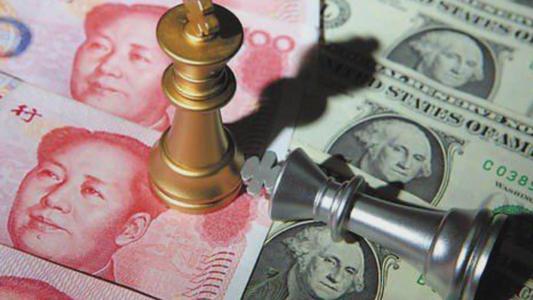BEIJING, July 17 (Xinhua) -- Chinese currency yuan or RMB is expected to resume a wave of appreciation amid volatility based on various indicators, but faces greater uncertainty in the future, say experts.
With the global monetary easing and recent rally on China's equity market, the RMB exchange rate has appreciated sharply since July. Although the offshore RMB against the U.S. dollar once again fell below the 7.02 mark in Beijing time on Tuesday, the U.S. dollar had been declining against RMB from around 7.15 since June, and was close to 6.98 on July 9, almost losing all its gains during January to May and then consolidated around 7.
As China has established a market-oriented mechanism on RMB exchange rate, experts attribute the strong RMB exchange rate to beliefs that China is on track for impressive economic recovery from the COVID-19 shock thanks to its effective efforts to contain the outbreak. What's more, foreign capital is keeping optimistic about A-shares, and a large amount of capital is flowing into Chinese market, which also speaks for a stronger RMB in the past weeks.
If the dollar's risk aversion decreases, it will further promote the appreciation of RMB but as the biggest uncertainty is still China-U.S. relations, its unpredictability has suppressed the appreciation of RMB to a certain extent, said Xiao Lisheng, an associate research fellow of Institute of World Economics and Politics (IWEP) at the Chinese Academy of Social Sciences (CASS).
China's import and export data in June was better than expected. Besides, both the official purchasing managers index (PMI) and Caixin PMI showed expansion in the industry. Latest data shows that China's epidemic has been effectively controlled and the national economy has also rebounded.
According to data released by National Bureau of Statistics Thursday, China's gross domestic product (GDP) in the first half of this year was 45.66 trillion yuan, down 1.6 percent year on year, but second-quarter GDP expanded 3.2 percent year on year, as compared to 6.8 percent on-year decrease in the first quarter.
Affected by the COVID-19 pandemic and the monetary and fiscal stimulus policies in major economies, the U.S. dollar index has fallen slightly while asset prices in major countries have risen, which were the factors that led to the increase in China's foreign exchange reserves in June, according to Wang Chunying, a spokeswoman for the State Administration of Foreign Exchange (SAFE).
"The current overseas situation of the pandemic and the world economy remains grim and complex, with increasing fluctuations in global financial markets. China has made significant achievements in prevention and control of the epidemic, while accelerating the resumption of production. Various economic indicators have improved marginally, and the economy is gradually recovering," Wang said.
Guan Tao, the global chief economist of BOC International (China) Limited said that, since China's PMI index has been above the boom and bust line for four consecutive months, the performance of export and utilization of foreign capital has exceeded market expectations, and the economy has also achieved a positive growth of 3.2 percent in the second quarter. Therefore, China's economy has the advantage of taking the lead in the global recovery, which is better than market expectations. The economy basically plays a supporting role in the RMB exchange rate, which tends to stabilize and rise, and in the second half of this year, supports from economic fundamentals are likely to gradually appear and stabilize the RMB exchange rate, Guan Tao added.
The world's second-largest economy has remained attractive for investors despite the impact of the pandemic, and China has seen all fund types register net inflows in the first five months of this year, according to research released on Tuesday by Fitch Ratings, one of the world's three biggest rating agencies.
Total open-end mutual fund assets in China, for example, swelled by 20 percent from January to May from a year earlier to 15.8 trillion yuan driven by institutional and retail demand, a faster economic recovery and recent substantial growth in money supply, Fitch said.
Zach Pandl, the co-head of global foreign exchange and emerging market strategy at Goldman Sachs said, RMB may continue to strengthen against the U.S. dollar in the next 12 months, hitting a 6.70 high, mainly because of the healthy development of China's economy. "China is recovering strongly from the novel coronavirus epidemic crisis," said Pandl.
Despite the recent upward trend in RMB exchange rate, experts warn that the RMB exchange rate may face greater uncertainty for the second half of 2020 or even in a longer period.
Zhang Ming, director of international investment research office of IWEP under CASS, pointed out that there are two main lines affecting exchange rate. If the exchange rate trend is dominated by economic fundamentals, then the RMB exchange rate against the U.S. dollar is expected to appreciate moderately. If the exchange rate trend is dominated by China-U.S. frictions, RMB may depreciate to a certain extent.
According to the latest forecast of the International Monetary Fund (IMF) in June 2020, the U.S. economy will shrink by 8.0 percent in 2020, while China's economy will grow by 1.0 percent. Zhang Ming believes that in light of the quarterly economic growth, China's economy may show a trend of low-speed and then higher-speed recovery while the U.S. economy is likely to contract deeply in the second and third quarters of this year.
This means that if the economic fundamentals are dominant, the spread between U.S. and China interest rates is expected to continue to expand in the second half of 2020, and the U.S. dollar index may be down to 91 to 93, corresponding to the exchange rate of RMB against the U.S. dollar, which is expected to rise to 6.7 to 6.8, Zhang Ming told Xinhua. (Contributed by Han Jie and edited by Duan Jing with Xinhua Silk Road, duanjing@xinhua.org)




 A single purchase
A single purchase









